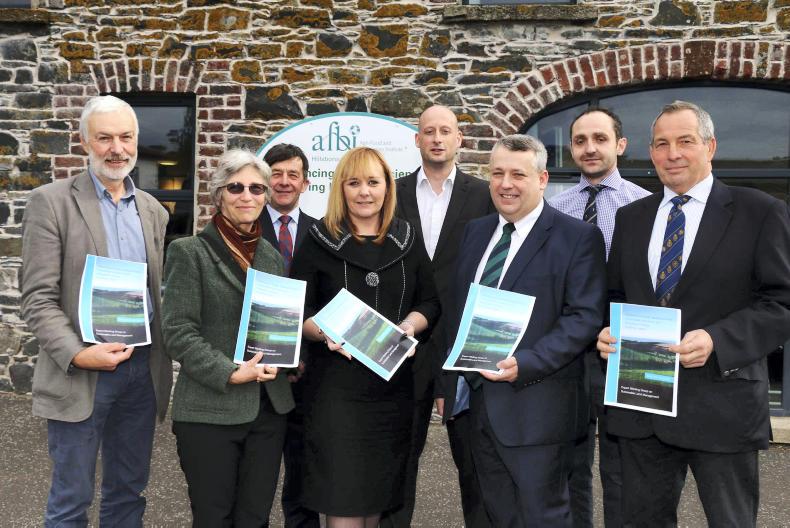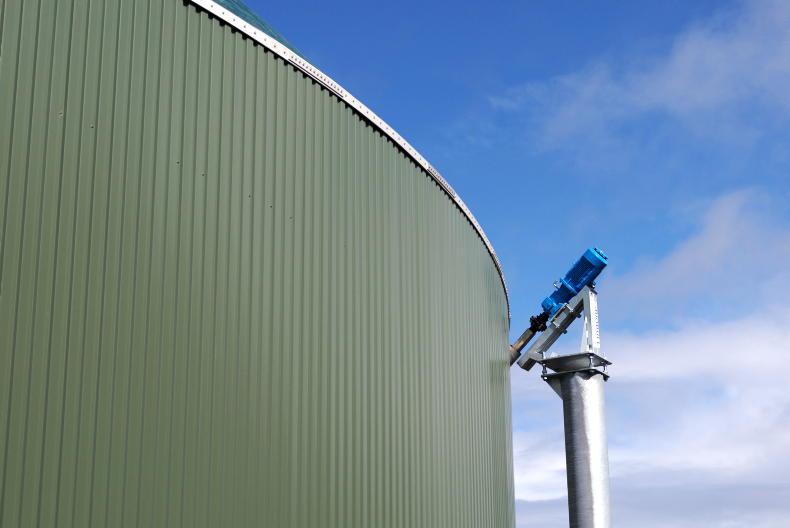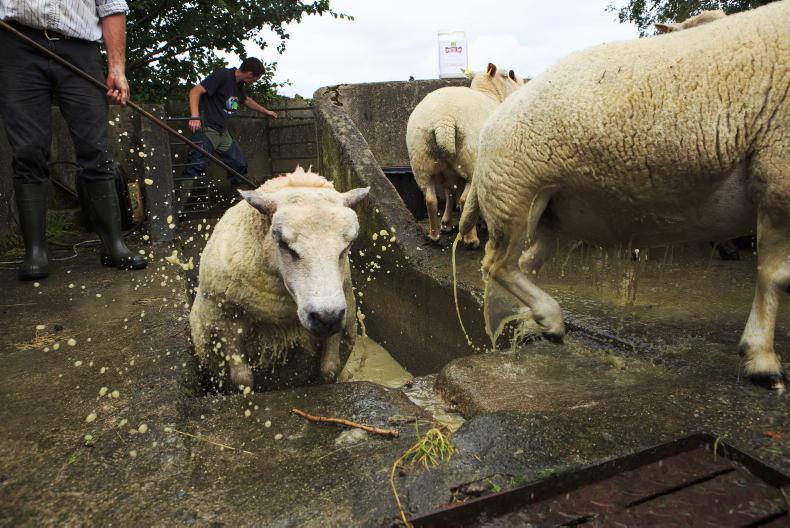Outside of the intensive pig and poultry sector, the issue of ammonia emissions from NI agriculture is something that few people in the NI agri-food industry had paid much attention to in recent years.
Ammonia is not a greenhouse gas so it tended to be ignored. But the issue has become more prominent in the last year with a number of applicants to Tier 2 of the Farm Business Improvement Scheme blocked in planning because a new livestock building is in close proximity to a designated site or priority habitat such as a heath or raised bog.
The implications of that are significant as it could limit any future investment or growth in the farming industry in NI. It prompted the former Agriculture Minister Michelle McIlveen to task the expert group led by Dr John Gilliland, and which previously had developed a land strategy for NI, to look at the ammonia issue.
The report out this week, which extends to over 100 pages, sets out in detail why ammonia emissions are important, identifies gaps in knowledge, and makes recommendations on what farmers can do to limit the problem.
It also highlights that the problem is most acute in NI, with emissions per square kilometre 50% greater than in the Republic of Ireland, and double that of England and Wales. That is due to NI having a more intensive livestock sector than other parts of these islands, with 70% of emissions in NI coming from cattle, 13% from poultry, 7% from pigs and 2% from sheep. A total of 91% of all ammonia emissions in NI come from agriculture.
The environmental issue around ammonia is that when lost to the atmosphere it is then deposited as various nitrogen compounds, which can have extremely negative consequences for plants adapted to low nitrogen conditions.
The effects are most clearly seen in designated sites and priority habitats, where these plants are out-competed by more nitrogen-tolerant plants, leading to a loss of biodiversity. Lichens and bog mosses are among those plants most at risk, although the point made by environmentalists is that the loss of these plants is only indicative of a much wider problem. Ammonia in the air can react with other molecules to form ammonium sulphate and ammonium nitrate, which can be damaging to human health, although the precise effect on agriculture is not clear.
Legislation
Also driving change is legislation, with the UK signed up to a United Nations Protocol for an 8% cut in ammonia emissions by 2020, and NI committed to a number of international and European agreements to protect biodiversity. Only one of 49 priority habitats in NI are classed at favourable status.
“For the agri-food sector to achieve good environmental performance, excessive ammonia emissions from farms must be addressed,” notes the Gilliland-led report.
Up to now, the main environmental focus has been around water pollution from agriculture, and specifically phosphorus getting into lakes and rivers (the main driver behind the land management strategy). “The issue of ammonia is more acute today. But they are both important in the medium term,” said Gilliland. He also maintained that good practice on farms will reduce both phosphorus run-off and ammonia emissions at the same time.
Ammonia – the knowledge gap
Perhaps the main objective for the expert group has been to find solutions that deliver environmental improvements, without cutting output from NI agriculture.
However, while the science behind phosphorus run-off is reasonably well understood, there is a significant knowledge gap in how ammonia emissions should be measured and what effect various mitigation strategies might have. It is something noted by John Gilliland in his forward to the ‘‘Making Ammonia Visible’’ report, where he also points out that there has been a significant lack of communication with farmers around the issue.
As a result, the key recommendation coming from the group is for a new partnership approach to be developed between industry and government. The aim is to communicate with, and educate farmers on ammonia emissions, fill in the knowledge gaps and implement a range of mitigating measures.
To fill the knowledge gap, the group recommends putting in place at least 15 monitoring sites to measure ammonia emissions across NI (only three at present). Also, DAERA should commission new research to ensure that models to predict emissions from NI agriculture are more accurate.
For example, at present the emission factor for slurry systems assumes that cattle are housed in cubicles with scraped solid floors. However, it is thought that emissions from slatted accommodation (predominant in NI) could be much less.
In addition, work is required to quantify the effect of reducing crude protein in the diets of livestock on subsequent emissions of ammonia (less crude protein going in should reduce nitrogen excretion in urine, and lead to less ammonia), and to look at the possible role of slurry additives in reducing ammonia loss.
What can
farmers do?
The report from the expert group sets out a number of actions that could reduce or mitigate ammonia emissions from agriculture.
With livestock housing and hard standing areas responsible for 36% of all emissions from farming (ammonia is created when faeces and urine are mixed), the first, and perhaps the most important recommendation, is for farmers to extend the grazing season.
Other recommendations include the use of treated or stabilised urea fertilisers which are less vulnerable to denitrification (releasing ammonia) when spread.
The group would like to see farmers switching from CAN (which is also vulnerable to denitrification) to stabilised urea, and the use of straight urea fertiliser banned from 2020.
In terms of slurry spreading, responsible for 28% of emissions, ammonia loss can be significant when spreading in hot, dry and windy weather. Spreading with a dribble bar or trailing shoe also results in much lower emissions. As a result, the group recommends that the sale of tankers with splash plates is prohibited from 2020, and the use of splash plates totally banned by 2025.
Other actions to reduce ammonia loss include:
Keeping collecting yards and hardstanding areas clean.Reducing crude protein in livestock diets.Using best genetics to increase feed efficiency (less nitrogen excreted per kilo of meat produced).Establishing woody areas around livestock units to capture ammonia.Covering outdoor slurry stores.A new approach
to planning
The expert group has also come forward with a number of recommendations designed to help remove the current impasse in planning for new livestock housing.
In the last year, a number of applications have been held up because of their close proximity to a designated site of priority habitat, with the NI Environment Agency (part of DAERA) insisting that most of these sites have already reached a critical level for ammonia emissions.
In response, the Gilliland-led expert group recommends that DAERA should adopt a new approach to include improved communication about the planning process and possible ammonia mitigation options that are available.
The group also wants DAERA to facilitate applicants who are encountering difficulties to have access to scientists and experts who could help inform applicants on a cost-effective ammonia mitigation strategy that could help them secure successful planning consent.
Outside of the intensive pig and poultry sector, the issue of ammonia emissions from NI agriculture is something that few people in the NI agri-food industry had paid much attention to in recent years.
Ammonia is not a greenhouse gas so it tended to be ignored. But the issue has become more prominent in the last year with a number of applicants to Tier 2 of the Farm Business Improvement Scheme blocked in planning because a new livestock building is in close proximity to a designated site or priority habitat such as a heath or raised bog.
The implications of that are significant as it could limit any future investment or growth in the farming industry in NI. It prompted the former Agriculture Minister Michelle McIlveen to task the expert group led by Dr John Gilliland, and which previously had developed a land strategy for NI, to look at the ammonia issue.
The report out this week, which extends to over 100 pages, sets out in detail why ammonia emissions are important, identifies gaps in knowledge, and makes recommendations on what farmers can do to limit the problem.
It also highlights that the problem is most acute in NI, with emissions per square kilometre 50% greater than in the Republic of Ireland, and double that of England and Wales. That is due to NI having a more intensive livestock sector than other parts of these islands, with 70% of emissions in NI coming from cattle, 13% from poultry, 7% from pigs and 2% from sheep. A total of 91% of all ammonia emissions in NI come from agriculture.
The environmental issue around ammonia is that when lost to the atmosphere it is then deposited as various nitrogen compounds, which can have extremely negative consequences for plants adapted to low nitrogen conditions.
The effects are most clearly seen in designated sites and priority habitats, where these plants are out-competed by more nitrogen-tolerant plants, leading to a loss of biodiversity. Lichens and bog mosses are among those plants most at risk, although the point made by environmentalists is that the loss of these plants is only indicative of a much wider problem. Ammonia in the air can react with other molecules to form ammonium sulphate and ammonium nitrate, which can be damaging to human health, although the precise effect on agriculture is not clear.
Legislation
Also driving change is legislation, with the UK signed up to a United Nations Protocol for an 8% cut in ammonia emissions by 2020, and NI committed to a number of international and European agreements to protect biodiversity. Only one of 49 priority habitats in NI are classed at favourable status.
“For the agri-food sector to achieve good environmental performance, excessive ammonia emissions from farms must be addressed,” notes the Gilliland-led report.
Up to now, the main environmental focus has been around water pollution from agriculture, and specifically phosphorus getting into lakes and rivers (the main driver behind the land management strategy). “The issue of ammonia is more acute today. But they are both important in the medium term,” said Gilliland. He also maintained that good practice on farms will reduce both phosphorus run-off and ammonia emissions at the same time.
Ammonia – the knowledge gap
Perhaps the main objective for the expert group has been to find solutions that deliver environmental improvements, without cutting output from NI agriculture.
However, while the science behind phosphorus run-off is reasonably well understood, there is a significant knowledge gap in how ammonia emissions should be measured and what effect various mitigation strategies might have. It is something noted by John Gilliland in his forward to the ‘‘Making Ammonia Visible’’ report, where he also points out that there has been a significant lack of communication with farmers around the issue.
As a result, the key recommendation coming from the group is for a new partnership approach to be developed between industry and government. The aim is to communicate with, and educate farmers on ammonia emissions, fill in the knowledge gaps and implement a range of mitigating measures.
To fill the knowledge gap, the group recommends putting in place at least 15 monitoring sites to measure ammonia emissions across NI (only three at present). Also, DAERA should commission new research to ensure that models to predict emissions from NI agriculture are more accurate.
For example, at present the emission factor for slurry systems assumes that cattle are housed in cubicles with scraped solid floors. However, it is thought that emissions from slatted accommodation (predominant in NI) could be much less.
In addition, work is required to quantify the effect of reducing crude protein in the diets of livestock on subsequent emissions of ammonia (less crude protein going in should reduce nitrogen excretion in urine, and lead to less ammonia), and to look at the possible role of slurry additives in reducing ammonia loss.
What can
farmers do?
The report from the expert group sets out a number of actions that could reduce or mitigate ammonia emissions from agriculture.
With livestock housing and hard standing areas responsible for 36% of all emissions from farming (ammonia is created when faeces and urine are mixed), the first, and perhaps the most important recommendation, is for farmers to extend the grazing season.
Other recommendations include the use of treated or stabilised urea fertilisers which are less vulnerable to denitrification (releasing ammonia) when spread.
The group would like to see farmers switching from CAN (which is also vulnerable to denitrification) to stabilised urea, and the use of straight urea fertiliser banned from 2020.
In terms of slurry spreading, responsible for 28% of emissions, ammonia loss can be significant when spreading in hot, dry and windy weather. Spreading with a dribble bar or trailing shoe also results in much lower emissions. As a result, the group recommends that the sale of tankers with splash plates is prohibited from 2020, and the use of splash plates totally banned by 2025.
Other actions to reduce ammonia loss include:
Keeping collecting yards and hardstanding areas clean.Reducing crude protein in livestock diets.Using best genetics to increase feed efficiency (less nitrogen excreted per kilo of meat produced).Establishing woody areas around livestock units to capture ammonia.Covering outdoor slurry stores.A new approach
to planning
The expert group has also come forward with a number of recommendations designed to help remove the current impasse in planning for new livestock housing.
In the last year, a number of applications have been held up because of their close proximity to a designated site of priority habitat, with the NI Environment Agency (part of DAERA) insisting that most of these sites have already reached a critical level for ammonia emissions.
In response, the Gilliland-led expert group recommends that DAERA should adopt a new approach to include improved communication about the planning process and possible ammonia mitigation options that are available.
The group also wants DAERA to facilitate applicants who are encountering difficulties to have access to scientists and experts who could help inform applicants on a cost-effective ammonia mitigation strategy that could help them secure successful planning consent.









SHARING OPTIONS